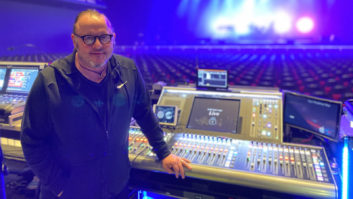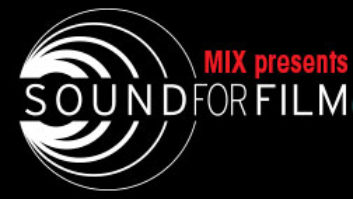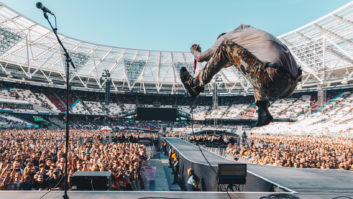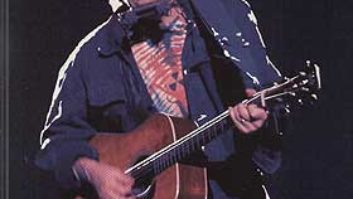New York, NY (November 19, 2018)—Simple Minds is best known in the United States for the eternally omnipresent “Don’t You Forget About Me,” but the band hadn’t played a full-fledged tour here since the ’90s. That changed this past fall when the group hit the road hard, backing its latest album, Walk Between Worlds, for a seven-week, 31-show run that ended this month, playing 3,000 to 4,000-seat venues across the continent.
Making up for lost time, the six-member band, led by remaining original Minds Jim Kerr (vocals) and Charlie Burchill (guitar), brought muscle to the group’s epic ’80s sound, aided nightly by Belgium-based, longtime FOH engineer Olivier Gerard and monitor man Mikey Gibbard, who looked after control gear and monitors provided by Clair Global’s UK arm, Britannia Row.
Gerard switched to an SSL Live L200 console in 2018. “I had a month at home and I said, ‘Well, let’s try to understand it,’” he recalled. “I worked with my multitracks and it sounded amazing straight away. I went from one song to the fifth song to the tenth song and I didn’t have to change my faders much; it sounded ‘already there.’ It’s an amazing desk once you’ve got it in your head.”
Snapshots for 60 songs reside in the desk—a necessity to ensure the tunes are presented properly. “The music in the ’80s was very produced, so all the reverbs and effects must change to match the sound of that particular era,” he said. “Whenever the song starts, people are brought back to where they were listening to the song back then, so I keep the energy that the band is bringing live, but I try to be very faithful to the record.”
While opting for mostly internal effects, he uses some outboard gear—a TC Electronic R4000 on the drums, a Bricasti M7 on vocals and a Lexicon 300—to replicate the sound of an era that leaned heavily on reverb. “I program at home on my monitoring and get the songs right, and then when I come here, I have to match what is coming out of my board to the system and the acoustics of the venue,” said Gerard. “One out of 15 times, you get a really good P.A., a really good room and everything sounds how you would like it to sound. Most of the time, though, you have to battle against the elements to get it the best you can—and that’s the challenge of mixing live.”
DPA mics have graced the band’s stage since an acoustic tour in 2017, with drums surrounded by 2011s and a Shure 91 in the kick to capture Cherisse Osei. “She drums hard! She’s an unbelievable musician,” Gerard noted. Most of the instruments are DI’d through Radial J48s to units like Two Notes Torpedo Loadboxes and such. Linear DPA d:dicate 4018s are used for backing vocals, but Kerr sticks with a Beta58 capsule on a Shure digital wireless. Gerard laughed, “I tried to change it, but he said, “I’ve used this for 40 years. Why do you want me to change now?’ Which is fair enough.” Later, he explained, “If something sounds good but messes up their comfort, I’d rather not have it because I want them to feel the very best they can. You can have a brilliant sound, brilliant balance, brilliant mix, but if they’re not into it, you’ve missed it. On the other hand, if they are very good but the sound isn’t, it’s still going to be a good gig.”
At stageside, Gibbard likewise is focused on keeping the band in the zone. This year marked his first time on an SSL L500, and he’s now a convert: “It’s like black magic, what goes on inside; the stereo summation of this board is unbelievable. I’ve never heard anything sound so close to an XL-4 in terms of how pure the sound is. Whatever band I work for, as long as the budget’s there, I’ll be going for this for sure.”
Looking after 14 stereo mixes for band and crew, he mostly uses stock effects, and only very occasionally a TC Electronic M4000: “I’ve got quite a lot of reverbs—10 reverbs, two delays. Everyone’s got their own reverb for vocals, two different reverbs for drums, I’ve got delay on Jim plus a plate, and there’s one song that requires a sort of tape delay on the snare, so I punch that in and out as needed.”
Burchill’s monitors are strictly d&b audiotechnik M2 wedges—“He does like it loud”—and a kicker and stray monitor can be found elsewhere on the stage, but by and large, the group sports Ultimate Ears UE18 ear buds on Sennheiser 6000 wireless packs.
Despite the pressure to deliver after so many years away from the United States, the mood was calm and assured. “I am very lucky to work with them because Simple Minds is a live band,” mused Gerard. “They don’t need to do this anymore; they are rich. If they do this, it’s because it’s their thing— they want to enjoy and entertain people. They have the right mindset, and because of their experience, they also know, ‘Oh, I know the hall here. Don’t worry too much, it’s going to be ok.’ They’re very cool to work with.”
Simple Minds • www.simpleminds.com
Britannia Row • www.britanniarow.com
SSL • www.solid-state-logic.com
DPA • www.dpamicrophones.com





